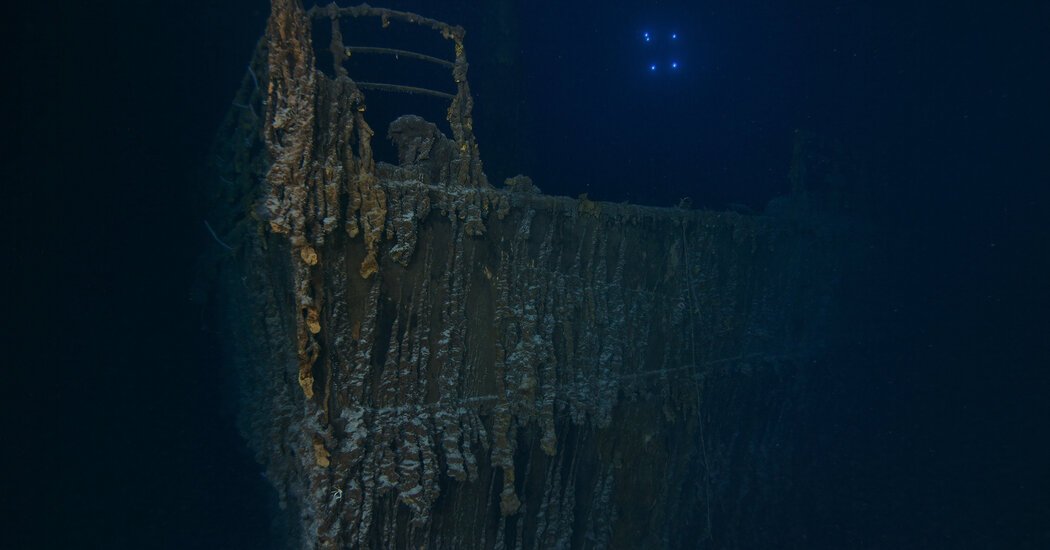
In its first expedition to the Titanic in 14 years, the company with exclusive salvage rights to the wreckage site said it had located a bronze statue thought to have been lost forever, and it also discovered some deterioration of the ship.
RMS Titanic Inc., the Atlanta-based company that has recovered thousands of artifacts from the ship over decades, said in a news release on Monday that it had started its expedition on July 12 and spent 20 days at the site, sending remotely operated vehicles to the ship. Researchers brought back two million photos.
But the company did not retrieve any artifacts this time, changing its plans after lawsuits from the federal government and criticism from scientists who believe that the site should be left alone as a memorial to the victims. The expedition comes about one year after the Titan submersible disaster killed a maritime expert who led research for the company.
A bronze statue of the Roman goddess Diana was a highlight.
Last caught on camera in 1986 and thought to be gone for good by most experts, “Diana of Versailles,” a two-foot tall bronze statuette of the Roman goddess Diana, was spotted by the expedition team.
Finding the statue of Diana had been a priority for the team, according to the company’s news release. The replica once stood in the first-class lounge of the ship on a mantle, but the lounge was torn open when the ship sank and the statue was thrown into a debris field.
The figure of Diana, the Roman goddess of the hunt, was found lodged into the ocean floor with an arm raised from the ground still reaching for her arrow. Her bronze coat barely stood out against the dark sediment.
The bow (where Jack and Rose stood in the 1997 movie) sustained damage.
The footage shows the partial collapse of a railing at the bow of the ship. The Titanic’s bow is featured in a famous scene in the 1997 film “Titanic,” in which Jack holds Rose from behind as she pretends to fly. (The image was used in movie posters.) As recently as 2022, images from a different expedition showed the bow’s railing still intact.
Tomasina Ray, the director of collections at RMS Titanic, said in a news release that the team was saddened by the evidence of decay, “which has only strengthened our commitment to preserving Titanic’s legacy.”
Researchers used two remotely operated vehicles to capture the images and data of the wreck site. The RMS Titanic team is now focused on processing the data and images to share findings with scientific communities.
RMS Titanic has faced backlash in the past.
While the company has held the exclusive rights to salvage any artifacts from the wreck for three decades, RMS Titanic has faced efforts from the federal government and scientists to try to block it from disturbing the wreck site and removing objects from it.
The expedition in July was led for research and not recovery, but during seven of the company’s nine expeditions since 1987, teams have recovered about 5,500 artifacts, according to the company.
The company tried to sell artifacts in the early 2000s, according to the National Oceanic and Atmospheric Administration. Some scientists have wished for the Titanic to be left untouched to memorialize the lives lost in 1912.
The Titanic lies in international waters off the coast of Newfoundland, Canada, and there is an agreement between Britain and the United States to protect the site. The United States passed a law in 2017 that required government approval to salvage or physically alter the wreck site.
In 2020, the United States tried to sue RMS Titanic after the company announced that it would seek to recover the Marconi wireless telegraph from the ship, which would require cutting into the vessel. A federal judge ruled that the company could go ahead with its plans.
Plans were changed after the Titan submersible disaster.
About a year ago, the U.S. government filed a motion to intervene and argued that RMS Titanic needed government approval before it could gain access to the ship’s remains and debris.
It came after the Titan disaster in June 2023, when five people trying to visit the site were killed when the submersible imploded. RMS Titanic’s director of underwater research, Paul-Henri Nargeolet, was among those who died.
The Titan was owned by a different company, but the tragedy raised questions over expeditions to the shipwreck.
Before the implosion, RMS Titanic told the court that it would recover the telegraph without federal approval. But in an October 2023 court filing, it said it would halt an upcoming recovery mission, “out of respect for P.H. Nargeolet and his family, and the other four people who perished so recently at the site.”
Whether or not the company will continue to extract artifacts from the site in the future is uncertain. A company spokesman said in an email to The New York Times on Monday that it currently does not have any plans.
“The company is going through the data from this expedition to establish next steps,” the statement said.
The U.S. attorney for the Eastern District of Virginia said the case against the company is still ongoing.
Federal investigators are still looking into the Titan’s implosion, and the exact cause has not been determined. Mr. Nargeolet’s family has filed a lawsuit against OceanGate Expeditions, the manufacturer.






